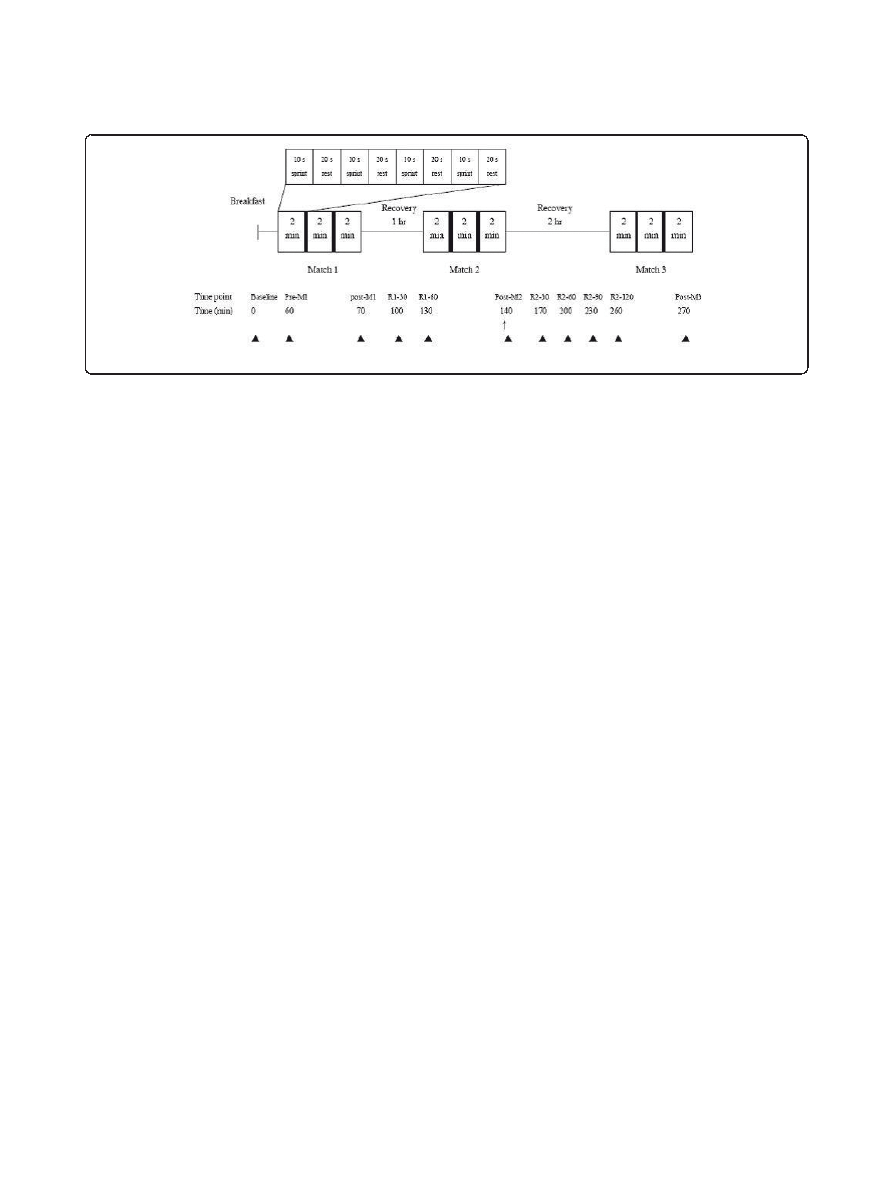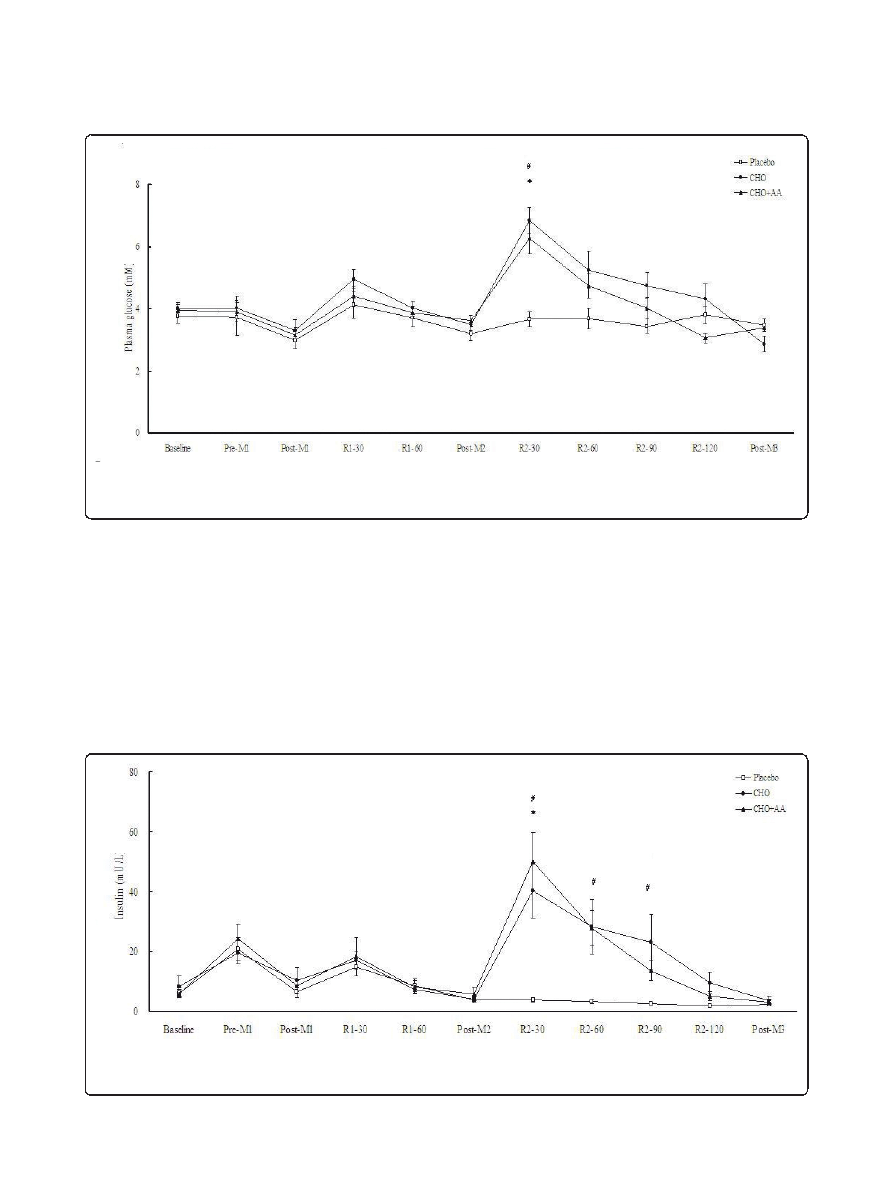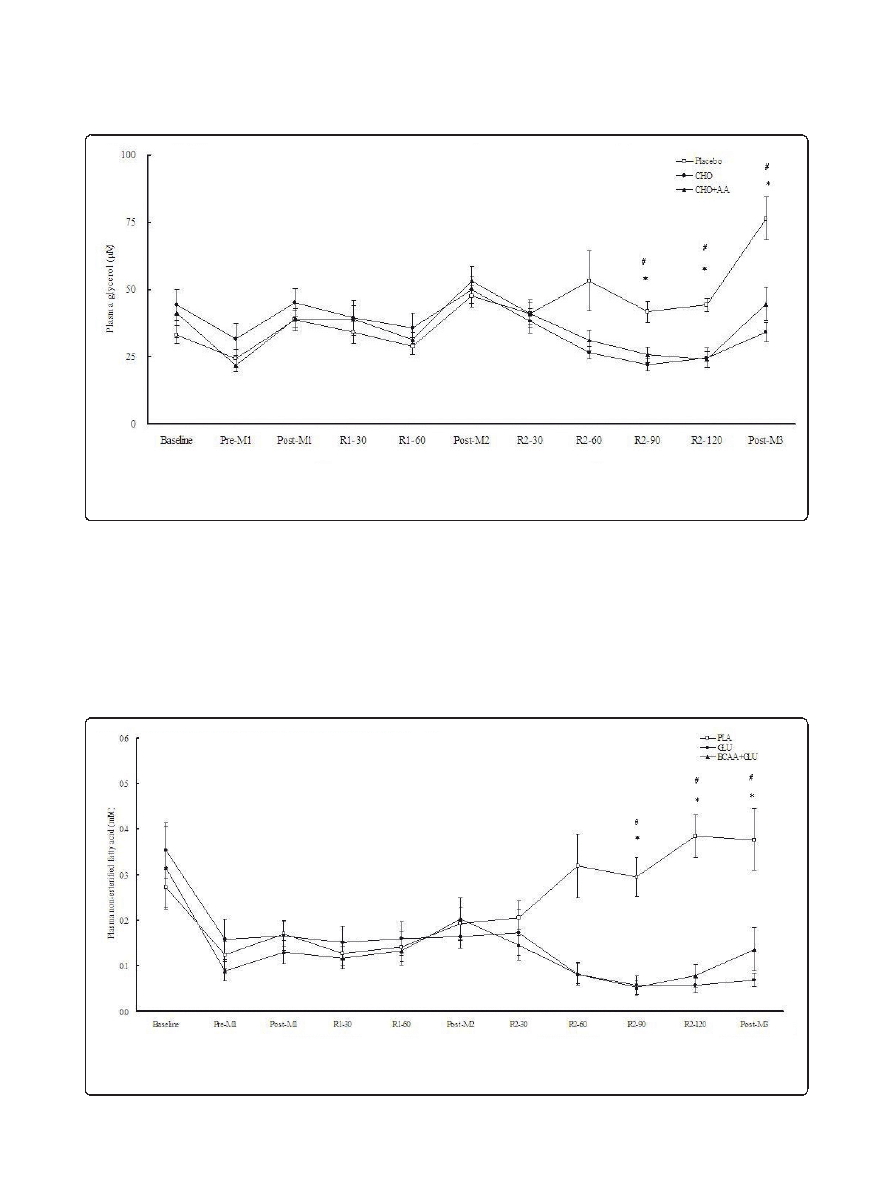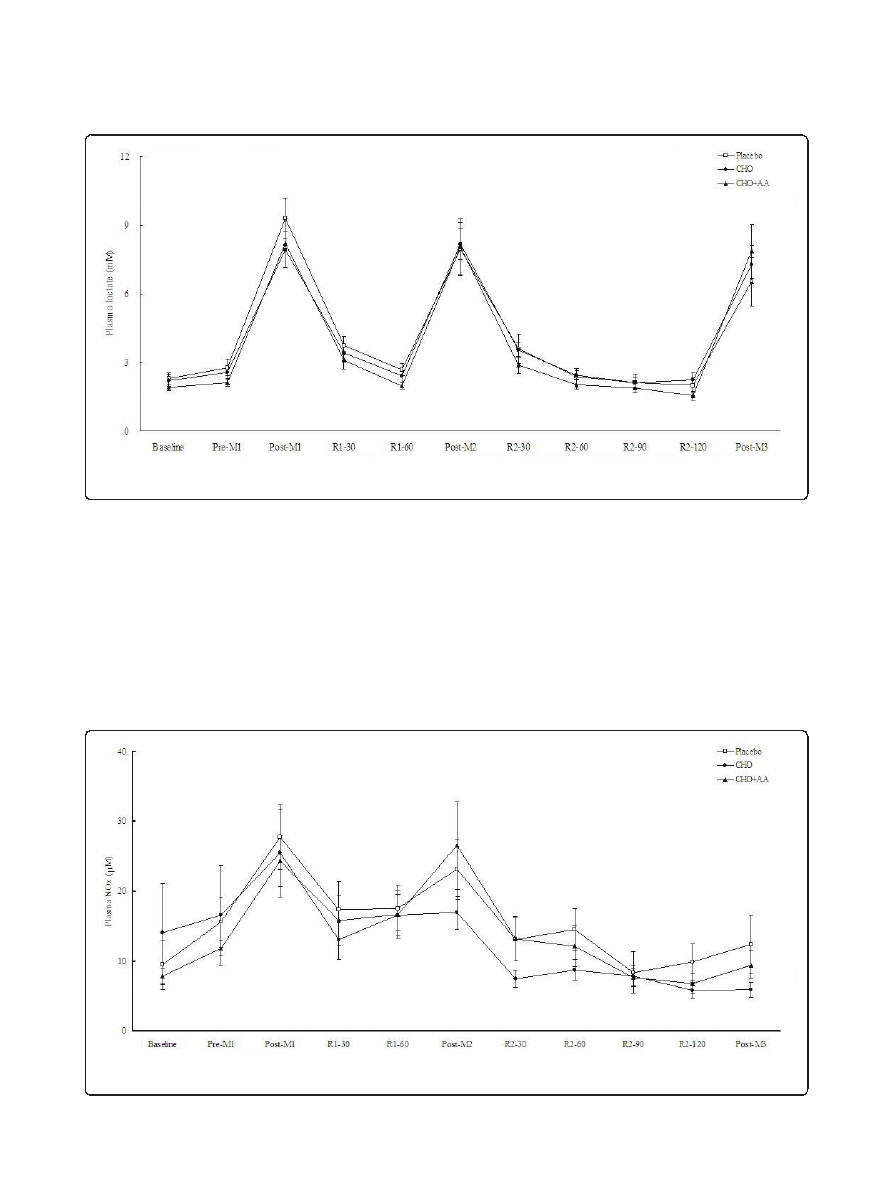
R E S E A R C H A R T I C L E
Open Access
Effects of carbohydrate, branched-chain amino
acids, and arginine in recovery period on the
subsequent performance in wrestlers
Tsong-Rong Jang
1
, Ching-Lin Wu
2
, Chai-Ming Chang
3
, Wei Hung
4,5
, Shih-Hua Fang
3
and Chen-Kang Chang
4,5*
Abstract
Many athletes need to participate in multiple events in a single day. The efficient post-exercise glycogen recovery
may be critical for the performance in subsequent exercise. This study examined whether post-exercise
carbohydrate supplementation could restore the performance in the subsequent simulated wrestling match. The
effect of branched-chain amino acids and arginine on glucose disposal and performance was also investigated.
Nine well-trained male wrestlers participated in 3 trials in a random order. Each trial contained 3 matches with a 1-
hr rest between match 1 and 2, and a 2-hr rest between match 2 and 3. Each match contained 3 exercise periods
interspersed with 1-min rests. The subjects alternated 10-s all-out sprints and 20-s rests in each exercise period. At
the end of match 2, 3 different supplementations were consumed: 1.2 g/kg glucose (CHO trial), 1 g/kg glucose +
0.1 g/kg Arg + 0.1 g/kg BCAA (CHO+AA trial), or water (placebo trial). The peak and average power in the 3
matches was similar in the 3 trials. After the supplementation, CHO and CHO+AA trial showed significantly higher
glucose and insulin, and lower glycerol and non-esterified fatty acid concentrations than the placebo trial. There
was no significant difference in these biochemical parameters between the CHO and CHO+AA trials.
Supplementation of carbohydrate with or without BCAA and arginine during the post-match period had no effect
on the performance in the following simulated match in wrestlers. In addition, BCAA and arginine did not provide
additional insulinemic effect.
Keywords: high-intensity intermittent exercise, insulinemic, exercise performance, exercise recovery
Introduction
Carbohydrate availability is one of the crucial factors for
performance in endurance [1] and high-intensity inter-
mittent exercise [2]. It has been well-documented that
carbohydrate supplementation before a single-bout of
endurance [3] and high-intensity intermittent exercise
[4] could improve the performance. In real circum-
stances, many athletes undergo more than 1 training
session per day. In addition, many competitions require
athletes to participate in multiple events in a single day.
Therefore, adequate nutritional strategies during the
short-term post-exercise recovery period may be critical
for the performance in subsequent exercise. Several stu-
dies have shown that ingestion of protein with
carbohydrate after exercise increases muscle glycogen
resynthesis rate, compared to the same amount of car-
bohydrate [5,6]. The increased muscle glycogen recovery
may lead to the improved performance during subse-
quent endurance exercise [7].
Muscle glycogen resynthesis after exercise consists of
two phases. The initial insulin-independent phase that
lasts approximately 1 hour has a higher resynthesis rate.
It is followed by an insulin-dependent phase with a
lower rate that lasts several hours [8]. Previous studies
have suggested that branched-chain amino acids
(BCAA) and arginine may help improve both phases.
Studies in rats have shown that BCAA could stimulate
insulin-independent glucose uptake in skeletal muscle
by increasing the translocation of glucose transporter
(GLUT)-4 and GLUT-1 to the sarcolemma [9]. Leucine
also activated glycogen synthetase via activation of
mammalian target of rapamycin (mTOR) signals in
* Correspondence: wspahn@seed.net.tw
4
Department of Exercise Health Science, National Taiwan College of Physical
Education, 16, Sec 1, Shuan-Shih Rd, Taichung, 404, Taiwan
Full list of author information is available at the end of the article
Jang
et al. Journal of the International Society of Sports Nutrition 2011, 8:21
http://www.jissn.com/content/8/1/21
© 2011 Jang et al; licensee BioMed Central Ltd. This is an Open Access article distributed under the terms of the Creative Commons
Attribution License (http://creativecommons.org/licenses/by/2.0), which permits unrestricted use, distribution, and reproduction in
any medium, provided the original work is properly cited.

isolated muscles [10]. Isoleucine increased insulin-inde-
pendent glucose uptake and glycogen synthesis in C
2
C
12
myotubes [11]. In addition, nitric oxide (NO), a product
of arginine, could increase the insulin-independent
expression and translocation of GLUT-4 in rat skeletal
muscles [12]. The vasodilation effect of arginine could
increase blood flow and substrate delivery to the muscle
and further increase glycogen recovery [13].
BCAA and arginine may also facilitate the insulin-
dependent phase by inducing insulin secretion [14,15].
The consumption of leucine and arginine along with
glucose could result in higher insulinemic response
compared to glucose alone in healthy subjects at rest
[16]. In addition, the supplementation of leucine in
combination with carbohydrate resulted in higher post-
exercise insulin concentration and greater muscle glyco-
gen recovery compared to the same amount of carbohy-
drate in athletes [5,17]. Arginine supplementation after
endurance exercise could also increase glucose and insu-
lin concentrations during the recovery period in trained
athletes [18]. Another study revealed that arginine
increased insulin-mediated whole-body glucose disposal
in healthy subjects [19], which might help to increase
post-exercise glycogen resynthesis. On the other hand, a
study using isotope-labeled glucose revealed that protein
hydrolysate with or without leucine had no effect on
post-exercise glucose disposal, compared to the same
amount of carbohydrate, despite higher insulinemic
responses [20].
Wrestling is a sport characterized by high-intensity
bouts interspersed with brief periods of mild- to moder-
ate-intensity work or rest [21]. Olympic and interna-
tional wrestling events require athletes to compete in
multiple matches in one day. The rest between matches
are usually 1-3 hrs. It has been shown that a free-style
wrestling match decreased the glycogen level in the vas-
tus lateralis muscle by 21.5% [22]. Several studies have
reported post-match blood lactate concentration at 10.5-
20 mM [22-25], indicating that carbohydrate is the
major energy source in wrestling. If appropriate nutri-
tion/supplementation is not taken, it is hypothesized
that the low muscle glycogen level resulted from pre-
vious matches would impair the performance in the
subsequent match. Therefore, this study investigated the
effects of 2 isocaloric supplements, carbohydrate or car-
bohydrate plus BCAA and arginine, consumed during
the post-match recovery period on the performance in
the subsequent match in well-trained college wrestlers.
The purpose was two-fold: to examine (1) whether car-
bohydrate supplementation could restore the perfor-
mance and (2) whether BCAA and arginine could
provide additive effect on glucose disposal during the
recovery and the performance in the subsequent match.
Material and methods
Subjects
Nine well-trained male wrestlers were recruited from
National Taiwan College of Physical Education, Tai-
chung, Taiwan. Their age was 19.2 ± 0.4 (mean ± SEM)
years, the height was 1.69 ± 0.02 m, the body weight
was 72.18 ± 2.71 kg, the body fat was 15.5 ± 1.6%, and
˙V
O
2max
was 55.5 ± 1.0 ml/kg/min. The subjects were
free of known cardiovascular disease risks and muscu-
loskeletal injuries. The subjects had not taken any pro-
tein supplement in the previous 3 months. All subjects
have undergone regular wrestling training for at least 4
years and competed in national or international level.
The subjects were asked to maintain their regular train-
ing schedule and diet habits during the study period,
except on the day before each trial when all training
was avoided. All subjects gave their written informed
consent after the experimental procedure and potential
risks were explained. The study protocol was approved
by the Human Subject Committee of National Taiwan
College of Physical Education.
Study design
This study used a double-blind, randomized cross-over
design. The procedure of exercise tests and blood and
gas samplings is shown in Figure 1. Each subject com-
pleted 3 trials in a random order according to their
order of admission to this study. Each trial was sepa-
rated by at least 2 weeks. The same food was provided
in the lunch and dinner on the day before, and the
breakfast on the day of each trial. The lunch and dinner
were meal boxes purchased from a local restaurant. The
2 meals combined to provide approximately 1434 kcal,
with 49.7% energy from carbohydrate, 30.1% from fat,
and 20.2% from protein. The diet analysis was per-
formed by a dietitian using Taiwanese food exchange
table [26]. The breakfast contained white bread 1.2 g/kg,
jam 0.1 g/kg, butter 0.l g/kg, and soybean milk 5 ml/kg
(6.2 kcal/kg, containing carbohydrate 1.0 g/kg, protein
0.24 g/kg, and fat 0.14 g/kg). For a 70-kg subject, the
breakfast contained 434 kcal, including 70 g carbohy-
drate, 16.8 g protein, and 9.8 g fat.
Measurement of cardiopulmonary function
The cardiopulmonary function was measured approxi-
mately 1-2 weeks prior to the trials using an electrically
braked cycle ergometer (ERG 550, Bosch, Stuttgart, Ger-
many). The subjects warmed up at 50 W for 5 min, fol-
lowed by incremental steps of 25 W every 3 min. The
breath-by-breath gas analysis was performed using a gas
analyzer (Vmax 29C, Sensormedics, Yorba Linda, CA,
USA). The
˙V
O
2max
was considered to be achieved if
˙V
O
2
increased by no more than 2 ml/kg/min after
Jang
et al. Journal of the International Society of Sports Nutrition 2011, 8:21
http://www.jissn.com/content/8/1/21
Page 2 of 11

increasing the workload or a respiratory exchange ratio
was larger than 1.10.
Experimental procedure
The subjects reported to the laboratory in the early
morning after an overnight fast. A cannula was put in
the antecubital vein by licensed personnel. After a
blood sample was taken in a fasted state to serve as
the baseline, the subjects consumed the standardized
breakfast. The exercise test started 1 hr after the
breakfast was consumed. Each trial contained 3
matches. At the end of the second match, 3 different
supplementations were consumed: 1.2 g/kg glucose
(CHO trial), 1 g/kg glucose + 0.1 g/kg Arg + 0.1 g/kg
BCAA (leucine: isoleucine: valine = 2:1:1, CHO+AA
trial), or water (placebo trial). All supplementations
were dissolved in 600 ml lemon flavored water to
make the tastes similar. The subjects were allowed to
drink water ad libtum in the first trial, while the tim-
ing and amount of consumption were recorded. The
timing and amount of water consumption were
repeated in the following trials.
Exercise tests
The high-intensity intermittent exercise test was
designed to mimic the duration of the actual wrestling
competition. The tests were performed on a Monark
cycle ergometer (894E, Monark, Varberg, Sweden). Each
trial contained 3 matches with a 1-hr rest between
match 1 and 2 and a 2-hr rest between match 2 and 3.
A match contained 3 exercise periods lasting 2 minutes
each with a work to rest ratio of 10 seconds: 20 seconds.
After each exercise period, a 2 minute rest period was
provided before the next exercise period. The load was
0.1 kp/kg body weight. The subjects were asked to pedal
as fast as possible with vocal encouragement by research
personnel. In the rest periods the load was removed and
the subjects were asked to pedal at 60 rpm. The peak
and average power of each sprint was recorded.
Blood sample collection
Blood samples were collected via an indwelled cannula
(20G). The cannula was frequent flushed by sterilized
saline to keep it patent throughout the experiment. Ten
milliliters of blood sample were collected into an EDTA
tube at each sampling time. Hematological analysis was
performed immediately after the samples were taken.
Thereafter, the rest samples were centrifuged at 1500 ×
g (Eppendorf 5810, Hamburg, Germany) to extract
plasma. The aliquoted plasma samples were stored at
-70°C before analysis.
Biochemical and hormone measurements
The research personnel who conducted the analysis
were blind to the group of the samples. Hemoglobin
concentration and hematocrit in whole blood was mea-
sured by a hematology analyzer (KX-21N, Sysmex Cor-
poration, Kobe, Japan) to correct for the change in
plasma volume [27]. Plasma NO
x
concentration was
measured with modified Griess reaction using a com-
mercial kit (Sigma, St. Louis, MO, USA). The absor-
bance at 540 nm was measured with a microplate
spectrophotometer (Benchmark Plus, Bio-Rad, Hercules,
CA, USA). Plasma concentrations of insulin were mea-
sured by electrochemiluminescence (Elecsys 2010, Roche
Diagnostics, Basel, Switzerland) with the kit provided by
the manufacturer. Plasma glucose, glycerol and non-
esterfied fatty acid (NEFA) were measured with an auto-
matic analyzer (Hitachi 7020, Tokyo, Japan) using com-
mercial kits (Randox, Antrim, UK).
Statistical analysis
All values were expressed as means ± SEMs. The area
under the curve (AUC) was calculated for plasma con-
centrations of glucose and insulin, as well as total carbo-
hydrate and fat oxidation, during the 2-hr recovery
period after the second match. The changes in exercise
performance, plasma concentrations of metabolites, and
substrate oxidation rates were analyzed by a two-way
Figure 1 Study protocol.
■: 1-min rest; ↑: supplementation; ▲: blood sampling.
Jang
et al. Journal of the International Society of Sports Nutrition 2011, 8:21
http://www.jissn.com/content/8/1/21
Page 3 of 11

analysis of variance with repeated measures. If the treat-
ment or interaction effect was significant, the differences
among the 3 trials at the same time point were identi-
fied by post hoc Bonferroni test. The AUC and total
carbohydrate and fat oxidation were analyzed by a one-
way analysis of variance with repeated measures. If the
main effect was significant, the differences among the 3
trials were identified by post hoc Bonferroni test. The
analysis was performed with SPSS for Windows 15.0
(SPSS, Chicago, IL, USA). A P value less than .05 was
considered statistically significant.
Results
The peak and average power in the 3 matches was simi-
lar in the 3 trials (Table 1). The power drop between
match 1 and match 2, as well as between match 1 and
match 3, were also similar in the 3 trials. Plasma glucose
and insulin concentrations in the 3 trials were shown in
Figures 2 and 3, respectively. After supplementations at
the end of match 2, the CHO and CHO+AA trial
showed significantly higher glucose concentration at 30
min, and significantly higher insulin concentration after
30, 60, and 90 min. Compared to the placebo trial, the
CHO and CHO+AA trial also showed significantly
higher AUC in glucose (Placebo: 428.69 ± 24.80; CHO:
621.85 ± 41.28; CHO+AA: 550.66 ± 32.89 arbitrary unit;
p < 0.01) and insulin concentrations (Placebo: 368.99 ±
68.24; CHO: 2947.01 ± 665.08; CHO+AA: 2896.27 ±
557.40 arbitrary unit; p < 0.01) during the 2-hr recovery
period after match 2. However, there was no significant
difference between the CHO and CHO+AA trial in
either glucose or insulin concentration at any time
point. The AUC of plasma glucose and insulin concen-
trations were also similar between the CHO and CHO
+AA trials.
The supplementation of CHO and CHO+AA resulted
in significantly lower plasma concentrations of glycerol
and NEFA at 90 and 120 min after match 2, as well as
immediately after match 3 (Figures 4 and 5). Plasma lac-
tate concentrations were not significantly different
among the 3 trials at any time point (Figure 6).
Plasma NO
x
concentrations in the 3 trials were shown
in Figure 7. Despite the supplementation of arginine in
the CHO+AA trial, there was no significant difference
in NO
x
concentration among the 3 trials at any time
point.
Discussion
To our knowledge, this is the first study that investi-
gated the effect of supplementation during a short-term
recovery period on the subsequent simulated match per-
formance in combat sports. The results of this study
suggested that the supplementation of carbohydrate,
with or without additional BCAA and arginine, during
the recovery period after two matches had no effect on
the performance in the subsequent match in well-
trained male college wrestlers.
The few available studies investigating the effect of
carbohydrate and protein consumption during the post-
exercise recovery period on the performance in the sub-
sequent exercise have provided positive [7,28] and nega-
tive [29,30] results. The consumption of carbohydrate
and protein during the 4-hr recovery period after glyco-
gen-depleting exercise increased the time to exhaustion
in the subsequently exercise at 70-85%
˙V
O
2max
, com-
pared to a smaller or same amount of carbohydrate
alone [7,28]. The increase in performance may be attrib-
uted to higher glycogen resynthesis during the recovery
period [7]. However, the carbohydrate-protein supple-
mentation did not show any additional effect compared
to isocaloric carbohydrate [28]. On the other hand, con-
sumption of 0.6 g/kg/hr carbohydrate during the 2-hr
recovery after a glycogen-depleting exercise resulted in
similar time to exhaustion in the subsequent endurance
exercise, compared to 1.0 g/kg/hr carbohydrate or 0.6 g/
kg/h carbohydrate plus 0.4 g/kg/hr protein [29]. The
authors concluded that the additional energy, either in
carbohydrate or protein, did not provide additional
effect above 0.6 g/kg/hr carbohydrate during the 2-h
recovery period [29]. With carbohydrate intake of 0.8 or
1.2 g/kg/hr during the 4-hr post-exercise recovery per-
iod, the additional protein showed no effect on the run-
ning time to exhaustion at 85% VO
2max
in the
Table 1 Peak and average power in 3 matches in the 3
trials
1
Placebo
trial
CHO trial
CHO+AA
trial
Peak power
1st match (W/kg)
70.36 ± 3.38
71.24 ± 4.19 72.62 ± 4.59
2nd match (W/kg)
69.45 ± 5.40
69.05 ± 5.42 72.08 ± 6.14
3rd match (W/kg)
67.49 ± 4.81
68.72 ± 4.84 72.52 ± 8.18
Average power
1st match (W/kg)
61.97 ± 3.33
63.90 ± 3.82 64.24 ± 4.14
2nd match (W/kg)
61.41 ± 4.84
61.05 ± 4.59 63.48 ± 5.54
3rd match (W/kg)
59.27 ± 4.15
60.89 ± 4.42 63.85 ± 7.09
Drop in peak power
Match 1 - Match 2 (%) 1.93 ± 5.07
3.35 ± 4.36
1.49 ± 4.14
Match 1 - Match 3 (%) 4.62 ± 3.93
3.52 ± 3.75
2.17 ± 6.61
Drop in average power
Match 1 - Match 2 (%) 1.28 ± 5.18
4.58 ± 4.23
2.00 ± 4.14
Match 1 - Match 3 (%) 4.54 ± 4.10
4.65 ± 4.04
2.59 ± 6.45
1
Each trial contained 3 matches with a 1-hr rest between match 1 and 2 and
a 2-hr rest between match 2 and 3. A match contained 3 exercise periods
lasting 2 minutes each with a work to rest ratio of 10 seconds: 20 seconds.
After each exercise period, a 2 minute rest period was provided before the
next exercise period. The load was 0.1 kp/kg body weight. All values are
means ± SEMs. Data were analyzed by using repeated measures ANOVA with
time and group as factors. No significant main effect was observed for any of
the variables.
Jang
et al. Journal of the International Society of Sports Nutrition 2011, 8:21
http://www.jissn.com/content/8/1/21
Page 4 of 11

subsequent exercise, despite higher insulinemic response
[30]. One of the reasons that protein offered no additional
benefit may be the higher carbohydrate oxidation rate and
similar glycogen utilization rate during the subsequent
endurance exercise [31,32]. The aforementioned studies all
focused on endurance exercise. For the first time, this study
suggested that consumption of carbohydrate or carbohy-
drate plus BCAA and arginine during the recovery period
had no effect on the performance in the subsequent inter-
mittent high-intensity exercise in well-trained wrestlers.
It is generally believed that muscle glycogen resynth-
esis during the first 4 hours of recovery is proportional
to the amount of carbohydrate ingested during the per-
iod [33]. While some authors have reported increased
rates of muscle glycogen resynthesis following the addi-
tion of protein to carbohydrate during recovery periods
after glycogen-depleting exercise [17,34], others have
found no such effect despite higher insulinemic
response induced by protein [35-37]. A recent review
suggested that when carbohydrate intake is less than 1
Figure 2 Plasma glucose concentrations in the 3 trials. Data were analyzed by using repeated measures ANOVA with time and group as
factors. Treatment effect p = 0.006; time effect p < 0.001; interaction effect p < 0.001. *CHO trial significantly different from placebo trial at the
same time point (p < 0.05).
#
CHO+AA trial significantly different from placebo trial at the same time point (p < 0.05).
Figure 3 Plasma insulin concentrations in the 3 trials. Data were analyzed by using repeated measures ANOVA with time and group as
factors. Treatment effect p = 0.013; time effect p < 0.001; interaction effect p < 0.001. *CHO trial significantly different from placebo trial at the
same time point (p < 0.05).
#
CHO+AA trial significantly different from placebo trial at the same time point (p < 0.05).
Jang
et al. Journal of the International Society of Sports Nutrition 2011, 8:21
http://www.jissn.com/content/8/1/21
Page 5 of 11

g/kg/hr over the 2-6 hr post-exercise period, the addi-
tional protein would increase muscle glycogen resynth-
esis. On the other hand, when carbohydrate intake is
sufficient, i.e. larger than 1 g/kg/hr, the co-ingested pro-
tein would not provide additional effect on glycogen
resynthesis [38]. Our subjects consumed 0.5 (CHO+AA
trial) and 0.6 (CHO trial) g/kg/hr carbohydrate during
the recovery period, which may allow the additional
protein to result in higher glycogen resynthesis. How-
ever, we still found that plasma insulin and glucose con-
centrations were similar between the 2 trials, indicating
that glycogen resynthesis is likely also similar. In agree-
ment to our results, it was reported that consumption
of 0.6-0.8 g/kg/hr carbohydrate and 0.25-0.30 g/kg/hr
protein resulted in similar glycogen resynthesis rate dur-
ing a 4-hr post-exercise period compared to the
Figure 4 Plasma glycerol concentrations in the 3 trials. Data were analyzed by using repeated measures ANOVA with time and group as
factors. Treatment effect p = 0.262; time effect p < 0.001; interaction effect p < 0.001. *CHO trial significantly different from placebo trial at the
same time point (p < 0.05).
#
CHO+AA trial significantly different from placebo trial at the same time point (p < 0.05).
Figure 5 Plasma non-esterified fatty acid concentrations in the 3 trials. Data were analyzed by using repeated measures ANOVA with time
and group as factors. Treatment effect p = 0.017; time effect p < 0.001; interaction effect p < 0.001. *CHO trial significantly different from
placebo trial at the same time point (p < 0.05).
#
CHO+AA trial significantly different from placebo trial at the same time point (p < 0.05).
Jang
et al. Journal of the International Society of Sports Nutrition 2011, 8:21
http://www.jissn.com/content/8/1/21
Page 6 of 11

supplementations matched for energy [39] or carbohy-
drate [40].
The literature on the effects of BCAA on glucose
uptake and glycogen synthesis in skeletal muscles has
been equivocal [5,41-43]. It has been reported that sup-
plementation of leucine in combination with carbohy-
drate after exercise resulted in higher post-exercise
insulin concentration and greater muscle glycogen
recovery in athletes, compared to the same amount of
carbohydrate [5]. In addition, oral supplementation of
BCAA has been reported to increase glycogen synthase
activity in rat skeletal muscles [42]. Leucine has also
been shown to increase insulin-independent glucose
uptake in isolated rat skeletal muscles through phospha-
tidylinositol 3-kinase (PI3K) pathway [44]. On the other
hand, leucine infusion decreased glucose uptake in
human forearm muscles in a dose-dependent manner
despite the elevated plasma insulin levels [45]. Infusion
of amino acid mixtures containing BCAA and arginine
also impaired insulin-stimulated glucose disposal and
Figure 6 Plasma lactate concentrations in the 3 trials. Data were analyzed by using repeated measures ANOVA with time and group as
factors. Treatment effect p = 0.546; time effect p < 0.001; interaction effect p = 0.085.
Figure 7 Plasma NOx concentrations in the 3 trials. Data were analyzed by using repeated measures ANOVA with time and group as factors.
Treatment effect p = 0.533; time effect p = 0.002; interaction effect p < 0.001.
Jang
et al. Journal of the International Society of Sports Nutrition 2011, 8:21
http://www.jissn.com/content/8/1/21
Page 7 of 11

glycogen synthesis in human skeletal muscles by
increasing the inhibitory insulin receptor substrate-1
phosphorylation and decreasing PI3K activity [43,46].
The results on the effect of arginine on post-exercise
insulinemic response and glycogen recovery were also
mixed. It has been shown that carbohydrate oxidation
after exercise was lower after arginine supplementation,
indicating the increase of glucose availability for muscle
glycogen storage during recovery in well-trained cyclists.
However, muscle glycogen resynthesis rate only showed
an insignificant trend of increase [47]. Although arginine
supplementation after endurance exercise could increase
glucose and insulin concentrations during the recovery
period in trained athletes [18], it had no additional effect
on plasma glucose and insulin concentrations when co-
ingested with glucose [48]. Other studies in human sub-
jects have also failed to show the effect of arginine sup-
plementation combined with carbohydrate on post-
exercise glycogen recovery, compared to carbohydrate
alone [39,48].
The CHO and CHO+AA trial showed significantly
lower plasma concentrations of glycerol and NEFA than
the placebo trial during the recovery period after match
2. The higher insulin response in the CHO and CHO
+AA trials may suppress lipolysis and fat oxidation [49].
The higher plasma NEFA concentration at the onset of
match 3 in the placebo trial would lead the subjects to
use more fat as the energy source during the match.
Indeed, plasma lactate concentration at the end of
match 3 tended to be lower in the placebo trial.
All three trials in our study showed higher exercise-
induced NO production as NO
x
concentrations were
significantly elevated after each match. However, argi-
nine supplementation had no effect on exercise-induced
NO production in these well-trained subjects. This
result was in agreement with our previous study using
similar exercise protocol in college judo athletes [50].
Regular exercise training has been shown to increase
basal NO production [51] by stimulating endothelial
NO synthase expression and phosphorylation [52].
Therefore, it is possible that these athletes already had
higher basal concentration of NO than general popula-
tion and certain patients [53]. Thus, arginine supple-
mentation did not provide any additional effect on NO
production in our subjects.
The lack of effect of carbohydrate supplementation,
with or without BCAA and arginine, on the perfor-
mance of high-intensity intermittent exercise is in con-
trast to previous studies in which low muscle glycogen
content contributed to the development of fatigue in
such type of exercise [2,4,54,55]. Although muscle
biopsy was not performed, the exercise protocol used in
our study would significantly reduce the glycogen con-
tent in the working muscles. It has been shown that a
single bout of 30-s all-out cycling reduced muscle glyco-
gen by approximately 24% [56]. In addition, muscle gly-
cogen levels were decreased by 19.6-36.4% after 10 to 15
bouts of 6-s all-out cycling, interspersed with 30-s rests
[2,57]. Therefore, the decrease in muscle glycogen after
our simulated matches would be similar, or even larger,
than that in real wrestling matches [22]. Even though
the glycogen content in the working muscles would be
significantly decreased after two simulated matches in
our study, the performance in match 3 was not signifi-
cantly different from the previous two matches in all 3
trials. One possible explanation is that these experienced
wrestlers have the ability to recover quickly from the
previous matches. In agreement, it has been reported
that grip strength, isometric upper body pull strength,
hip and back strength, vertical jump, and isokinetic knee
extension peak torque were all generally maintained
throughout a 2-day, 5-match freestyle wrestling tourna-
ment [23]. A recent study on a 1-day 5-match Greco-
Roman wrestling tournament also revealed that these
parameters were generally maintained through the first
three matches [24]. The length and work:rest ratio of
the simulated match in this study resemble real wres-
tling competitions. It also resulted in the similar post-
match plasma lactate concentrations to those in the lit-
erature [22,58]. Therefore, it is possible that these well-
trained wrestlers are adapted to this type of exercise and
able to recover within 1 to 2 hours of rest. Furthermore,
well-trained endurance athletes can also maintain the
time to fatigue in intermittent exhaustive cycling exer-
cise despite lower muscle glycogen levels [59]. There-
fore, the well-trained wrestlers in this study may be able
to maintain the performance in the three matches with
or without the supplementation.
Another unique characteristic of this study is that sub-
jects consumed a carbohydrate-rich breakfast before the
exercise began. In previous studies investigated the
effect of ingestion of carbohydrate and protein (or
amino acids) during post-exercise recovery, subjects
were mostly at an overnight fasted state. It appears that
the carbohydrate in the breakfast was sufficient to main-
tain the euglycemic states throughout the entire study
period, even in the placebo trial. Although the breakfast
might mask the potential benefit of the supplementation
during the recovery period, it more closely reflects the
real-life behavior of athletes as they rarely participate in
matches in a fasted state.
The amount of BCAA consumed in this study, 7 g in
a 70-kg subject, was similar to the 6.5-15.8 g dosages
ingested before exercise in the literature [60-62]. The
amount of arginine consumed in this study, 7 g in a 70-
kg subject, has been shown to result in a significant
improvement of flow-mediated vasodilatation [63]. In
addition, it has been suggested that post-exercise
Jang
et al. Journal of the International Society of Sports Nutrition 2011, 8:21
http://www.jissn.com/content/8/1/21
Page 8 of 11

supplementation of 0.3-0.5 g total protein/kg/hr could
produce higher insulinemic responses [38]. Since whey
protein hydrolyate containes approximately 13.4% amino
acids as BCAA and arginine [17], we selected 0.1 g
amino acids/kg/hr in this study.
A limitation of this study is that muscle biopsy was
not performed because it would interfere with the per-
formance in the subsequent exercise. Future studies
with modified protocols may allow the biopsy procedure
and further clarify the effect of BCAA and arginine on
post-exercise glycogen recovery. Another limitation of
this study is that inflammatory response was not mea-
sured. Strenuous exercise such as the simulated match
in this study could result in significant inflammatory
response and muscle damage. However, there was no
significant difference in plasma concentrations of crea-
tine kinase and lactate dehydrogenase at the baseline
among the 3 trials (data not shown). It is reasonable to
assume that the 2-week period between each trial is suf-
ficient for the subjects to recover completely. The other
mechanisms that may affect the performance in multiple
wrestling matches, such as neuromuscular and/or psy-
chological fatigue, were not investigated in this study
and could be involved in future studies.
Conclusions
In conclusion, this study suggested that supplementation
of carbohydrate with or without BCAA and arginine
during the post-match period did not provide additional
effect on the performance in the following simulated
match in well-trained male wrestlers when a carbohy-
drate-rich breakfast was eaten. It is possible that factors
other than muscle glycogen content contribute to the
performance in multiple bouts of high-intensity inter-
mittent exercise. It is also possible that experienced
wrestlers have the ability to recovery quickly from pre-
vious matches with or without supplementation.
Furthermore, BCAA and arginine did not provide addi-
tional insulinemic effect when given after high-intensity
intermittent exercise.
List of abbreviations used
AUC: area under curve; BCAA: branched-chain amino acids; GLUT: glucose
transporter; NEFA: non-esterified fatty acid; NO: nitric oxide; PI3K:
phosphatidylinositol 3-kinase.
Acknowledgements and funding
We gratefully acknowledge the technical assistance of Mei-Hui Tseng and I-
Fan Chen and the enthusiastic support of the subjects who volunteered to
participate in this study. This study is supported by the grants from the
National Science Council, Taiwan (NSC-97-2320-B-028-002 and 98-2320-B-
028-001-MY3).
Author details
1
Department of Combat Sports, National Taiwan College of Physical
Education, 16, Sec 1, Shuan-Shih Rd, Taichung, 404, Taiwan.
2
Graduate
Institute of Sports and Health Management, National Chung Hsing
University, 250 Kuo Kuang Road, Taichung, 402, Taiwan.
3
Institute of
Athletics, National Taiwan College of Physical Education, 16, Sec 1, Shuan-
Shih Rd, Taichung, 404, Taiwan.
4
Department of Exercise Health Science,
National Taiwan College of Physical Education, 16, Sec 1, Shuan-Shih Rd,
Taichung, 404, Taiwan.
5
Sport Science Research Center, National Taiwan
College of Physical Education, 16, Sec 1, Shuan-Shih Rd, Taichung, 404,
Taiwan.
Authors
’ contributions
TRJ and CLW designed the study and assisted the manuscript preparation.
CMC and WH were responsible for conducting the study, including subject
recruitment, biochemical measurements, and data analysis. SHF assisted the
design of the study and manuscript preparation. CKC was responsible for
statistical analysis and manuscript preparation. All authors read and
approved the final manuscript.
Competing interests
The authors declare that they have no competing interests.
Received: 27 May 2011 Accepted: 22 November 2011
Published: 22 November 2011
References
1.
Johnson NA, Stannard SR, Thompson MW: Muscle triglyceride and
glycogen in endurance exercise: implications for performance. Sports
Med 2004, 34:151-164.
2.
Balsom PD, Gaitanos GC, Soderlund K, Ekblom B: High-intensity exercise
and muscle glycogen availability in humans. Acta Physiol Scand 1999,
165:337-345.
3.
Hargreaves M, Hawley JA, Jeukendrup A: Pre-exercise carbohydrate and
fat ingestion: effects on metabolism and performance. J Sports Sci 2004,
22:31-38.
4.
Welsh RS, Davis JM, Burke JR, Williams HG: Carbohydrates and physical/
mental performance during intermittent exercise to fatigue. Med Sci
Sports Exerc 2002, 34:723-731.
5.
van Loon LJ, Saris WH, Kruijshoop M, Wagenmakers AJ: Maximizing
postexercise muscle glycogen synthesis: carbohydrate supplementation
and the application of amino acid or protein hydrolysate mixtures. Am J
Clin Nutr 2000, 72:106-111.
6.
Berardi JM, Price TB, Noreen EE, Lemon PW: Postexercise muscle glycogen
recovery enhanced with a carbohydrate-protein supplement. Med Sci
Sports Exerc 2006, 38:1106-1113.
7.
Williams MB, Raven PB, Fogt DL, Ivy JL: Effects of recovery beverages on
glycogen restoration and endurance exercise performance. J Strength
Cond Res 2003, 17:12-19.
8.
Price TB, Rothman DL, Taylor R, Avison MJ, Shulman GI, Shulman RG:
Human muscle glycogen resynthesis after exercise: insulin-dependent
and -independent phases. J Appl Physiol 1994, 76:104-111.
9.
Nishitani S, Takehana K, Fujitani S, Sonaka I: Branched-chain amino acids
improve glucose metabolism in rats with liver cirrhosis. Am J Physiol
Gastrointest Liver Physiol 2005, 288:G1292-1300.
10.
Nishitani S, Takehana K: Pharmacological activities of branched-chain
amino acids: augmentation of albumin synthesis in liver and
improvement of glucose metabolism in skeletal muscle. Hepatol Res
2004, 30S:19-24.
11.
Doi M, Yamaoka I, Fukunaga T, Nakayama M: Isoleucine, a potent plasma
glucose-lowering amino acid, stimulates glucose uptake in C2C12
myotubes. Biochem Biophys Res Commun 2003, 312:1111-1117.
12.
Lira VA, Soltow QA, Long JH, Betters JL, Sellman JE, Criswell DS: Nitric oxide
increases GLUT4 expression and regulates AMPK signaling in skeletal
muscle. Am J Physiol Endocrinol Metab 2007, 293:E1062-1068.
13.
Jobgen WS, Fried SK, Fu WJ, Meininger CJ, Wu G: Regulatory role for the
arginine-nitric oxide pathway in metabolism of energy substrates. J Nutr
Biochem 2006, 17:571-588.
14.
Sener A, Blachier F, Rasschaert J, Mourtada A, Malaisse-Lagae F, Malaisse WJ:
Stimulus-secretion coupling of arginine-induced insulin release:
comparison with lysine-induced insulin secretion. Endocrinology 1989,
124:2558-2567.
15.
Sener A, Malaisse WJ: The stimulus-secretion coupling of amino acid-
induced insulin release: insulinotropic action of branched-chain amino
Jang
et al. Journal of the International Society of Sports Nutrition 2011, 8:21
http://www.jissn.com/content/8/1/21
Page 9 of 11

acids at physiological concentrations of glucose and glutamine. Eur J
Clin Invest 1981, 11:455-460.
16.
van Loon LJ, Saris WH, Verhagen H, Wagenmakers AJ: Plasma insulin
responses after ingestion of different amino acid or protein mixtures
with carbohydrate. Am J Clin Nutr 2000, 72:96-105.
17.
van Loon LJ, Kruijshoop M, Verhagen H, Saris WH, Wagenmakers AJ:
Ingestion of protein hydrolysate and amino acid-carbohydrate mixtures
increases postexercise plasma insulin responses in men. J Nutr 2000,
130:2508-2513.
18.
Tsai PH, Tang TK, Juang CL, Chen KW, Chi CA, Hsu MC: Effects of arginine
supplementation on post-exercise metabolic responses. Chin J Physiol
2009, 52:136-142.
19.
Paolisso G, Tagliamonte MR, Marfella R, Verrazzo G, D
’Onofrio F,
Giugliano D: L-arginine but not D-arginine stimulates insulin-mediated
glucose uptake. Metabolism 1997, 46:1068-1073.
20.
Kaastra B, Manders RJ, Van Breda E, Kies A, Jeukendrup AE, Keizer HA,
Kuipers H, Van Loon LJ: Effects of increasing insulin secretion on acute
postexercise blood glucose disposal. Med Sci Sports Exerc 2006,
38:268-275.
21.
Horswill CA: Applied physiology of amateur wrestling. Sports Med 1992,
14:114-143.
22.
Houston ME, Sharratt MT, Bruce RW: Glycogen depletion and lactate
responses in freestyle wrestling. Can J Appl Sport Sci 1983, 8:79-82.
23.
Kraemer WJ, Fry AC, Rubin MR, Triplett-McBride T, Gordon SE, Koziris LP,
Lynch JM, Volek JS, Meuffels DE, Newton RU, Fleck SJ: Physiological and
performance responses to tournament wrestling. Med Sci Sports Exerc
2001, 33:1367-1378.
24.
Barbas I, Fatouros IG, Douroudos II, Chatzinikolaou A, Michailidis Y,
Draganidis D, Jamurtas AZ, Nikolaidis MG, Parotsidis C, Theodorou AA,
Katrabasas I, Margonis K, Papassotiriou I, Taxildaris K: Physiological and
performance adaptations of elite Greco-Roman wrestlers during a one-
day tournament. Eur J Appl Physiol 2011, , 111: 1421-1436.
25.
Karnincic H, Tocilj Z, Uljevic O, Erceg M: Lactate profile during Greco-
Roman wrestling match. J Sports Sci Med 2009, 8:17-19.
26.
Huang SY: Dietary plan Taipei: Hua Shiang Yuan; 2006.
27.
Costill DL, Fink WJ: Plasma volume changes following exercise and
thermal dehydration. J Appl Physiol 1974, 37:521-525.
28.
Betts J, Williams C, Duffy K, Gunner F: The influence of carbohydrate and
protein ingestion during recovery from prolonged exercise on
subsequent endurance performance. J Sports Sci 2007, 25:1449-1460.
29.
Millard-Stafford M, Warren GL, Thomas LM, Doyle JA, Snow T, Hitchcock K:
Recovery from run training: efficacy of a carbohydrate-protein
beverage? Int J Sport Nutr Exerc Metab 2005, 15:610-624.
30.
Betts JA, Stevenson E, Williams C, Sheppard C, Grey E, Griffin J: Recovery of
endurance running capacity: effect of carbohydrate-protein mixtures. Int
J Sport Nutr Exerc Metab 2005, 15:590-609.
31.
Tsintzas K, Williams C, Boobis L, Symington S, Moorehouse J, Garcia-Roves P,
Nicholas C: Effect of carbohydrate feeding during recovery from
prolonged running on muscle glycogen metabolism during subsequent
exercise. Int J Sports Med 2003, 24:452-458.
32.
Wong SH, Williams C: Influence of different amounts of carbohydrate on
endurance running capacity following short term recovery. Int J Sports
Med 2000, 21:444-452.
33.
Ivy JL, Lee MC, Brozinick JT Jr, Reed MJ: Muscle glycogen storage after
different amounts of carbohydrate ingestion. J Appl Physiol 1988,
65:2018-2023.
34.
Ivy JL, Goforth HW Jr, Damon BM, McCauley TR, Parsons EC, Price TB: Early
postexercise muscle glycogen recovery is enhanced with a
carbohydrate-protein supplement. J Appl Physiol 2002, 93:1337-1344.
35.
Jentjens RL, van Loon LJ, Mann CH, Wagenmakers AJ, Jeukendrup AE:
Addition of protein and amino acids to carbohydrates does not
enhance postexercise muscle glycogen synthesis. J Appl Physiol 2001,
91:839-846.
36.
van Hall G, Shirreffs SM, Calbet JA: Muscle glycogen resynthesis during
recovery from cycle exercise: no effect of additional protein ingestion. J
Appl Physiol 2000, 88:1631-1636.
37.
Carrithers JA, Williamson DL, Gallagher PM, Godard MP, Schulze KE,
Trappe SW: Effects of postexercise carbohydrate-protein feedings on
muscle glycogen restoration. J Appl Physiol 2000, 88:1976-1982.
38.
Betts JA, Williams C: Short-term recovery from prolonged exercise:
exploring the potential for protein ingestion to accentuate the benefits
of carbohydrate supplements. Sports Med 2010, 40:941-959.
39.
Rotman S, Slotboom J, Kreis R, Boesch C, Jequier E: Muscle glycogen
recovery after exercise measured by 13C-magnetic resonance
spectroscopy in humans: effect of nutritional solutions. Magma 2000,
11:114-121.
40.
Betts JA, Williams C, Boobis L, Tsintzas K: Increased carbohydrate oxidation
after ingesting carbohydrate with added protein. Med Sci Sports Exerc
2008, 40:903-912.
41.
Iwanaka N, Egawa T, Satoubu N, Karaike K, Ma X, Masuda S, Hayashi T:
Leucine modulates contraction- and insulin-stimulated glucose transport
and upstream signaling events in rat skeletal muscle. J Appl Physiol 2010,
108:274-282.
42.
Nishitani S, Ijichi C, Takehana K, Fujitani S, Sonaka I: Pharmacological
activities of branched-chain amino acids: specificity of tissue and signal
transduction. Biochem Biophys Res Commun 2004, 313:387-389.
43.
Krebs M, Krssak M, Bernroider E, Anderwald C, Brehm A, Meyerspeer M,
Nowotny P, Roth E, Waldhausl W, Roden M: Mechanism of amino acid-
induced skeletal muscle insulin resistance in humans. Diabetes 2002,
51:599-605.
44.
Nishitani S, Matsumura T, Fujitani S, Sonaka I, Miura Y, Yagasaki K: Leucine
promotes glucose uptake in skeletal muscles of rats. Biochem Biophys Res
Commun 2002, 299:693-696.
45.
Schwenk WF, Haymond MW: Decreased uptake of glucose by human
forearm during infusion of leucine, isoleucine, or threonine. Diabetes
1987, 36:199-204.
46.
Tremblay F, Krebs M, Dombrowski L, Brehm A, Bernroider E, Roth E,
Nowotny P, Waldhausl W, Marette A, Roden M: Overactivation of S6 kinase
1 as a cause of human insulin resistance during increased amino acid
availability. Diabetes 2005, 54:2674-2684.
47.
Yaspelkis BB, Ivy JL: The effect of a carbohydrate-arginine supplement on
postexercise carbohydrate metabolism. Int J Sport Nutr 1999, 9:241-250.
48.
Robinson TM, Sewell DA, Greenhaff PL: L-arginine ingestion after rest and
exercise: effects on glucose disposal. Med Sci Sports Exerc 2003,
35:1309-1315.
49.
Horowitz JF, Mora-Rodriguez R, Byerley LO, Coyle EF: Lipolytic suppression
following carbohydrate ingestion limits fat oxidation during exercise.
Amer J Physiol 1997, 273:E768-775.
50.
Liu TH, Wu CL, Chiang CW, Lo YW, Tseng HF, Chang CK: No effect of
short-term arginine supplementation on nitric oxide production,
metabolism and performance in intermittent exercise in athletes. J Nutr
Biochem 2009, 20:462-468.
51.
Kingwell BA, Sherrard B, Jennings GL, Dart AM: Four weeks of cycle
training increases basal production of nitric oxide from the forearm. Am
J Physiol 1997, 272:H1070-1077.
52.
Hambrecht R, Adams V, Erbs S, Linke A, Krankel N, Shu Y, Baither Y,
Gielen S, Thiele H, Gummert JF, Mohr FW, Schuler G: Regular physical
activity improves endothelial function in patients with coronary artery
disease by increasing phosphorylation of endothelial nitric oxide
synthase. Circulation 2003, 107:3152-3158.
53.
Poveda JJ, Riestra A, Salas E, Cagigas ML, Lopez-Somoza C, Amado JA,
Berrazueta JR: Contribution of nitric oxide to exercise-induced changes in
healthy volunteers: effects of acute exercise and long-term physical
training. Eur J Clin Invest 1997, 27:967-971.
54.
Patterson SD, Gray SC: Carbohydrate-gel supplementation and endurance
performance during intermittent high-intensity shuttle running. Int J
Sport Nutr Exerc Metab 2007, 17:445-455.
55.
Little JP, Chilibeck PD, Ciona D, Forbes S, Rees H, Vandenberg A, Zello GA:
Effect of low- and high-glycemic-index meals on metabolism and
performance during high-intensity, intermittent exercise. Int J Sport Nutr
Exerc Metab 2010, 20:447-456.
56.
Barnett C, Carey M, Proietto J, Cerin E, Febbraio MA, Jenkins D: Muscle
metabolism during sprint exercise in man: influence of sprint training. J
Sci Med Sport 2004, 7:314-322.
57.
Gaitanos GC, Williams C, Boobis LH, Brooks S: Human muscle metabolism
during intermittent maximal exercise. J Appl Physiol 1993, 75:712-719.
58.
Tarnopolsky MA, Cipriano N, Woodcroft C, Pulkkinen WJ, Robinson DC,
Henderson JM, MacDougall JD: Effects of rapid weight loss and wrestling
on muscle glycogen concentration. Clinical Journal of Sport Medicine 1996,
6:78-84.
Jang
et al. Journal of the International Society of Sports Nutrition 2011, 8:21
http://www.jissn.com/content/8/1/21
Page 10 of 11

59.
McInerney P, Lessard SJ, Burke LM, Coffey VG, Lo Giudice SL, Southgate RJ,
Hawley JA: Failure to repeatedly supercompensate muscle glycogen
stores in highly trained men. Med Sci Sports Exerc 2005, 37:404-411.
60.
Mittleman KD, Ricci MR, Bailey SP: Branched-chain amino acids prolong
exercise during heat stress in men and women. Med Sci Sports Exerc
1998, 30:83-91.
61.
Davis JM, Welsh RS, De Volve KL, Alderson NA: Effects of branched-chain
amino acids and carbohydrate on fatigue during intermittent, high-
intensity running. Int J Sports Med 1999, 20:309-314.
62.
Blomstrand E, Hassmen P, Ek S, Ekblom B, Newsholme EA: Influence of
ingesting a solution of branched-chain amino acids on perceived
exertion during exercise. Acta Physiol Scand 1997, 159:41-49.
63.
Lekakis JP, Papathanassiou S, Papaioannou TG, Papamichael CM,
Zakopoulos N, Kotsis V, Dagre AG, Stamatelopoulos K, Protogerou A,
Stamatelopoulos SF: Oral L-arginine improves endothelial dysfunction in
patients with essential hypertension. Int J Cardiol 2002, 86:317-323.
doi:10.1186/1550-2783-8-21
Cite this article as: Jang et al.: Effects of carbohydrate, branched-chain
amino acids, and arginine in recovery period on the subsequent
performance in wrestlers. Journal of the International Society of Sports
Nutrition 2011 8:21.
Submit your next manuscript to BioMed Central
and take full advantage of:
•
Convenient online submission
•
Thorough peer review
•
No space constraints or color figure charges
•
Immediate publication on acceptance
•
Inclusion in PubMed, CAS, Scopus and Google Scholar
•
Research which is freely available for redistribution
Submit your manuscript at
www.biomedcentral.com/submit
Jang
et al. Journal of the International Society of Sports Nutrition 2011, 8:21
http://www.jissn.com/content/8/1/21
Page 11 of 11
Document Outline
- Abstract
- Introduction
- Material and methods
- Results
- Discussion
- Conclusions
- Acknowledgements and funding
- Author details
- Authors' contributions
- Competing interests
- References
Wyszukiwarka
Podobne podstrony:
W 21 Alkohole
21 02 2014 Wykład 1 Sala
21 Fundamnety przyklady z praktyki
BO I WYKLAD 01 3 2011 02 21
w 1 komunikacja 21 11 09 nst
21 25
21 23
2009 06 15 21;42;51
2011 03 05 21;05;08
2002 06 21
21
Kodeks pracy Dziennik Ustaw poz 94 nr 21 z 1998 roku
2011 03 05 21;10;59
2004 06 21
21 12 2008 1CB bardzo łatwy, Flash1CB bardzo łatwy
opis 21 04
więcej podobnych podstron